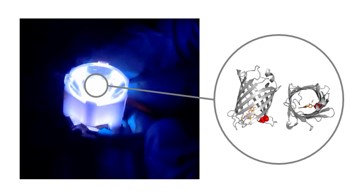An EU funded project, named ENABLED, is working on creating LEDs with artificial fluorescent proteins to make the lighting source more sustainable.
Currently, LED lamps consist of a blue-emitting chip and an optical filter made of inorganic phosphors, rare earth minerals that transforms blue light into the white light. This filter does not efficiently convert blue light, causing serious implications on visual acuity in children and sleep disorder in adults. Moreover, inorganic phosphors are quite scarce and are listed as one of the 27 critical raw materials by the European Union. It is expected that global reserves of inorganic phosphor will run out in 10-15 years if global demand for LEDs rises as expected, while the recycling process is quite inefficient.
To tackle the issue, the European Union established the ENABLED project standing for Engineering of Artificial Fluorescent Proteins for Biological Light Emitting Diodes. The project is coordinated by Rubén Costa, head of the Hybrid Optoelectronic Materials & Devices Lab at IMDEA Materials Institute, which was founded by the government in Madrid, Spain in 2007.

(Image: IMDEA Materials)
The ENABLED project will work to replace inorganic phosphor filters in LEDs by those nature uses deed down the sea. Three out of four sea creatures produce high power light using protein filters for hunting, communication or self-protection purposes. The main problem for the practical use of these proteins in LED lightning is to preserve them outside their aquatic environment. Rubén Costa’s group has managed to stabilize these fluorescent proteins in a plastic matrix without compromising their excellent brightness. This new technology is called Bio-LED and has already achieved up to 6 months of stability with a high efficiency using new polymer matrices and additives, while understanding deactivation mechanism.

(Image: IMDEA Materials)
A research team composed of computational experts, biochemists, chemists, synthetic biologists and optoelectronic professionals promise to produce genetically modified proteins produced by bacteria, in order to develop new filters that could level up the performance of the current Bio-LEDs. This multidisciplinary project is one of the leading examples in which synthetic biology serves to the artificial lighting technology.





 CN
TW
EN
CN
TW
EN






